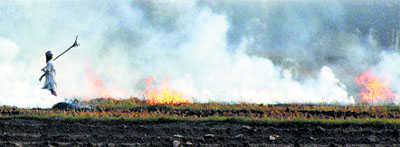
Sudhirendar Sharma
Writer, researcher and academic
Farm scientists claim that the recently released early maturing varieties of paddy (PR-121, PR-126, HKR-47, HKR-47 and HKR- 127) will help farmers avoid straw burning as they will gain a two-to-three-week window ahead of their preparations for the winter crop. An estimated 35 million tonnes of rice straw is consigned to flames over two to three weeks every year during October and November in Punjab and Haryana, engulfing the entire northern region with polluted air and resultant smog due to calm winter winds under low temperature conditions.
Given that these new varieties yield almost on a par with the popular long-duration paddy varieties like Pusa-44, scientists see no reason why widespread adoption of these early maturing paddy varieties will not free the region from the curse of smoke, smog and particulate pollution. In a recent note published in journal Current Science, scientists report the emergence of PR-121 as the most popular variety, claiming 7 lakh hectares (30 per cent) cultivated area since the 2016 season in Punjab. In contrast, area under the late-maturing Pusa-44 variety has come down to 20 per cent.
Scientists further argue that provision of machines like happy seeders, mulchers, rotavators and straw reapers by the government at the community level will provide end-to-end solution to the problem, as farmers will then be motivated to adopt short-duration varieties, knowing well that straw disposal solutions are at their doorstep. Hopefully, Punjab's farmers, threatened with fines and possibly prison sentences for rice straw burning, will queue up for buying short-duration seeds and avail themselves of the benefits of the subsidised machinery.
In Punjab, 75-80 per cent of area under rice is machine-harvested and based on the harvest index, 18-20 million tonnes of rice straw is produced in a season. With little use of paddy straw at the farm level, the debt-ridden farmers can ill afford the cost of labour to rid the farm of paddy stubbles. It is an unintended consequence of dependence on fertilisers that the nutritional value of straw gets compromised as a residue which is worthy of being torched only.
There is no denying that from the early days of the Green Revolution, farmers have been in the cusp of a technological trap which focused on productivity and economic returns while ignoring social, cultural and ecological aspects.
Far from seeking support for such decentralised initiatives, the political overture favours quick-fix solution of financial incentive to wean farmers away from straw burning. While an incentive of Rs 200 per acre may fulfill the National Green Tribunal (NGT) obligation of dissuading farmers from burning paddy straw, the question of disposing the humongous volume of farm waste has not been suitably addressed. Some centralised solutions, including turning straw into charcoal, have been only under active discussions.
It is clear that inadequate understanding of varying levels of causality and complexity in the past only contributed to enhancing farmers' vulnerabilities, and eventually added to their distress. And, it is no exaggeration that each new fix, technological and economic, will only accentuate farmers' vulnerabilities — paddy straw burning being no exception. While dissuading farmers from straw burning through financial incentive (provided funds are available) may work in the short term, medium- to long-term solutions rest on creating a science-society interface that will build on farmers' narrative for innovation and change. "Without empathy for nature and natural processes, collective learning as a means of addressing technological vulnerabilities cannot be induced," concludes Ajay Tripathi of the civil society, Kheti Virasat Mission, at Jaitu in Faridkot district.



























